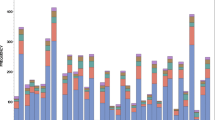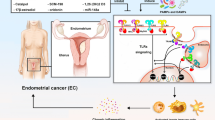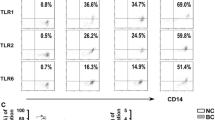Abstract
Recent studies have implicated inflammation in the initiation and progression of ovarian cancer, though the mechanisms underlying this effect are still not clear. Toll-like receptors (TLRs) allow immune cells to recognize pathogens and to trigger inflammatory responses. Tumor cell expression of TLRs can promote inflammation and cell survival in the tumor microenvironment. Here we sought to characterize the expression of TLRs in normal human ovaries, benign and malignant ovarian tumors from patients, and in established ovarian tumor cell lines. We report that TLR2, TLR3, TLR4, and TLR5 are strongly expressed on the surface epithelium of normal ovaries. In contrast to previous studies of uterus and endocervix, we found no cyclic variation in TLR expression occurred in murine ovaries. TLR2, TLR3, TLR4, and TLR5 are expressed in benign conditions, epithelial tumors, and in ovarian cancer cell lines. Variable expression of TLR6 and TLR8 was seen in benign and malignant epithelium of some patients, while expression of TLR1, TLR7, and TLR9 was weak. Normal and malignant ovarian stroma were negative for TLR expression. Vascular endothelial cells, macrophages, and occasional fibroblasts in tumors were positive. Functional activity for TLRs was demonstrated by stimulation of cell lines with specific ligands and subsequent activation and translocation of NFκB and release of the proinflammatory cytokines interleukin-6 and CCL-2. These studies demonstrate expression of multiple TLRs in the epithelium of normal ovaries and in ovarian tumor cells, and may indicate a mechanism by which epithelial tumors manipulate inflammatory pathways to facilitate tumor progression.



Similar content being viewed by others
References
DeNardo DG, Johansson M, Coussens LM (2008) Immune cells as mediators of solid tumor metastasis. Cancer Metastasis Rev 27:11–18
Karin M, Greten FR (2005) NF-kappaB: linking inflammation and immunity to cancer development and progression. Nat Rev Immunol 5:749–759
Burke F, Relf M, Negus R, Balkwill F (1996) A cytokine profile of normal and malignant ovary. Cytokine 8:578–585
Haskill S, Becker S, Fowler W, Walton L (1982) Mononuclear-cell infiltration in ovarian cancer I. Inflammatory-cell infiltrates from tumour and ascites material. Br J Cancer 45:728–736
Penson RT, Kronish K, Duan Z, Feller AJ, Stark P, Cook SE, Duska LR, Fuller AF, Goodman AK, Nikrui N, MacNeill KM, Matulonis UA, Preffer FI, Seiden MV (2000) Cytokines IL-1beta, IL-2, IL-6, IL-8, MCP-1, GM-CSF and TNF-alpha in patients with epithelial ovarian cancer and their relationship to treatment with paclitaxel. Int J Gynecol Cancer 10:33–41
Punnonen R, Teisala K, Kuoppala T, Bennett B, Punnonen J (1998) Cytokine production profiles in the peritoneal fluids of patients with malignant or benign gynecologic tumors. Cancer 83:788–796
Freedman RS, Deavers M, Liu J, Wang E (2004) Peritoneal inflammation—a microenvironment for Epithelial Ovarian Cancer (EOC). J Transl Med 2:23
Hagemann T, Wilson J, Burke F, Kulbe H, Li NF, Pluddemann A, Charles K, Gordon S, Balkwill FR (2006) Ovarian cancer cells polarize macrophages toward a tumor-associated phenotype. J Immunol 176:5023–5032
Wang X, Deavers M, Patenia R, Bassett RL Jr, Mueller P, Ma Q, Wang E, Freedman RS (2006) Monocyte/macrophage and T-cell infiltrates in peritoneum of patients with ovarian cancer or benign pelvic disease. J Transl Med 4:30–40
Robinson-Smith TM, Isaacsohn I, Mercer CA, Zhou M, Van Rooijen N, Husseinzadeh N, McFarland-Mancini MM, Drew AF (2007) Macrophages mediate inflammation-enhanced metastasis of ovarian tumors in mice. Cancer Res 67:5708–5716
Yu L, Chen S (2008) Toll-like receptors expressed in tumor cells: targets for therapy. Cancer Immunol Immunother 57:1271–1278
Kelly MG, Alvero AB, Chen R, Silasi DA, Abrahams VM, Chan S, Visintin I, Rutherford T, Mor G (2006) TLR-4 signaling promotes tumor growth and paclitaxel chemoresistance in ovarian cancer. Cancer Res 66:3859–3868
Fichorova RN, Cronin AO, Lien E, Anderson DJ, Ingalls RR (2002) Response to Neisseria gonorrhoeae by cervicovaginal epithelial cells occurs in the absence of Toll-Like receptor 4-mediated signaling. J Immunol 168:2424–2432
Fazeli A, Bruce C, Anumba DO (2005) Characterization of Toll-Like receptors in the female reproductive tract in humans. Hum Reprod 20:1372–1378
Pioli PA, Amiel E, Schaefer TM, Connolly JE, Wira CR, Guyre PM (2004) Differential expression of Toll-Like receptors 2 and 4 in tissues of the human female reproductive tract. Infect Immun 72:5799–5806
Aflatoonian R, Tuckerman E, Elliott SL, Bruce C, Aflatoonian A, Li TC, Fazeli A (2007) Menstrual cycle-dependent changes of Toll-like receptors in endometrium. Hum Reprod 22:586–593
Pivarcsi A, Nagy I, Koreck A, Kis K, Kenderessy-Szabo A, Szell M, Dobozy A, Kemeny L (2005) Microbial compounds induce the expression of pro-inflammatory cytokines, chemokines and human beta-defensin-2 in vaginal epithelial cells. Microbes Infect 7:1117–1127
Itoh H, Nasu K, Nishida M, Matsumoto H, Yuge A, Narahara H (2006) Human oviductal stromal fibroblasts, but not oviductal epithelial cells, express Toll-like receptor 4: the site-specific mucosal immunity of the human fallopian tube against bacterial infection. Am J Reprod Immunol 56:91–101
Gonzalez JM, Xu H, Ofori E, Elovitz MA (2007) Toll-like receptors in the uterus, cervix, and placenta: is pregnancy an immunosuppressed state? Am J Obstet Gynecol 197:296 e1–6
Shimada M, Hernandez-Gonzalez I, Gonzalez-Robanya I, Richards JS (2006) Induced expression of pattern recognition receptors in cumulus oocyte complexes: novel evidence for innate immune-like functions during ovulation. Mol Endocrinol 20:3228–3239
Girling JE, Hedger MP (2007) Toll-like receptors in the gonads and reproductive tract: emerging roles in reproductive physiology and pathology. Immunol Cell Biol 85(6):481–489
Rock FL, Hardiman G, Timans JC, Kastelein RA, Bazan JF (1998) A family of human receptors structurally related to Drosophila Toll. Proc Natl Acad Sci USA 95:588–593
Takeuchi O, Kawai T, Sanjo H, Copeland NG, Gilbert DJ, Jenkins NA, Takeda K, Akira S (1999) TLR6: a novel member of an expanding toll-like receptor family. Gene 231:59–65
Zarember KA, Godowski PJ (2002) Tissue expression of human Toll-like receptors and differential regulation of Toll-like receptor mRNAs in leukocytes in response to microbes, their products, and cytokines. J Immunol 168:554–561
Herath S, Williams EJ, Lilly ST, Gilbert RO, Dobson H, Bryant CE, Sheldon IM (2007) Ovarian follicular cells have innate immune capabilities that modulate their endocrine function. Reproduction 134:683–693
Molteni M, Marabella D, Orlandi C, Rossetti C (2006) Melanoma cell lines are responsive in vitro to lipopolysaccharide and express TLR-4. Cancer Lett 235:75–83
Krinke GJ (2004) Normative histology of organs. In: Hedrich HJ, Bullock G (eds) The laboratory mouse. Elsevier, London
Diaz-Meco MT, Municio MM, Sanchez P, Lozano J, Moscat J (1996) Lambda-interacting protein, a novel protein that specifically interacts with the zinc finger domain of the atypical protein kinase C isotype lambda/iota and stimulates its kinase activity in vitro and in vivo. Mol Cell Biol 16:105–114
Palazzo M, Balsari A, Rossini A, Selleri S, Calcaterra C, Gariboldi S, Zanobbio L, Arnaboldi F, Shirai YF, Serrao G, Rumio C (2007) Activation of enteroendocrine cells via TLRs induces hormone, chemokine, and defensin secretion. J Immunol 178:4296–4303
Takeuchi O, Hoshino K, Kawai T, Sanjo H, Takada H, Ogawa T, Takeda K, Akira S (1999) Differential roles of TLR2 and TLR4 in recognition of gram-negative and gram-positive bacterial cell wall components. Immunity 11:443–451
Adachi O, Kawai T, Takeda K, Matsumoto M, Tsutsui H, Sakagami M, Nakanishi K, Akira S (1998) Targeted disruption of the MyD88 gene results in loss of IL-1- and IL-18-mediated function. Immunity 9:143–150
Alexopoulou L, Holt AC, Medzhitov R, Flavell RA (2001) Recognition of double-stranded RNA and activation of NF-kappaB by Toll-like receptor 3. Nature 413:732–738
Yang Y, Liu B, Dai J, Srivastava PK, Zammit DJ, Lefrancois L, Li Z (2007) Heat shock protein gp96 is a master chaperone for toll-like receptors and is important in the innate function of macrophages. Immunity 26:215–226
Feuillet V, Medjane S, Mondor I, Demaria O, Pagni PP, Galan JE, Flavell RA, Alexopoulou L (2006) Involvement of Toll-like receptor 5 in the recognition of flagellated bacteria. Proc Natl Acad Sci USA 103:12487–12492
Fukata M, Michelsen KS, Eri R, Thomas LS, Hu B, Lukasek K, Nast CC, Lechago J, Xu R, Naiki Y, Soliman A, Arditi M, Abreu MT (2005) Toll-like receptor-4 is required for intestinal response to epithelial injury and limiting bacterial translocation in a murine model of acute colitis. Am J Physiol Gastrointest Liver Physiol 288:G1055–G1065
Macedo L, Pinhal-Enfield G, Alshits V, Elson G, Cronstein BN, Leibovich SJ (2007) Wound healing is impaired in MyD88-deficient mice: a role for MyD88 in the regulation of wound healing by adenosine A2A receptors. Am J Pathol 171:1774–1788
Shimada M, Yanai Y, Okazaki T, Noma N, Kawashima I, Mori T, Richards JS (2008) Hyaluronan fragments generated by sperm-secreted hyaluronidase stimulate cytokine/chemokine production via the TLR2 and TLR4 pathway in cumulus cells of ovulated COCs, which may enhance fertilization. Development 135:2001–2011
Bouman A, Moes H, Heineman MJ, de Leij LF, Faas MM (2001) The immune response during the luteal phase of the ovarian cycle: increasing sensitivity of human monocytes to endotoxin. Fertil Steril 76:555–559
Moeinpour F, Choudhry MA, Kawasaki T, Timares L, Schwacha MG, Bland KI, Chaudry IH (2007) 17beta-Estradiol normalizes Toll receptor 4, mitogen activated protein kinases and inflammatory response in epidermal keratinocytes following trauma-hemorrhage. Mol Immunol 44:3317–3323
Paimela T, Ryhanen T, Mannermaa E, Ojala J, Kalesnykas G, Salminen A, Kaarniranta K (2007) The effect of 17beta-estradiol on IL-6 secretion and NF-kappaB DNA-binding activity in human retinal pigment epithelial cells. Immunol Lett 110:139–144
Vegeto E, Ghisletti S, Meda C, Etteri S, Belcredito S, Maggi A (2004) Regulation of the lipopolysaccharide signal transduction pathway by 17beta-estradiol in macrophage cells. J Steroid Biochem Mol Biol 91:59–66
Schaefer TM, Fahey JV, Wright JA, Wira CR (2005) Innate immunity in the human female reproductive tract: antiviral response of uterine epithelial cells to the TLR3 agonist poly(I:C). J Immunol 174:992–1002
Ghosh M, Schaefer TM, Fahey JV, Wright JA, Wira CR (2008) Antiviral responses of human Fallopian tube epithelial cells to toll-like receptor 3 agonist poly(I:C). Fertil Steril 89:1497–1506
Lee JW, Choi JJ, Seo ES, Kim MJ, Kim WY, Choi CH, Kim TJ, Kim BG, Song SY, Bae DS (2007) Increased toll-like receptor 9 expression in cervical neoplasia. Mol Carcinog 46:941–947
Kim WY, Lee JW, Choi JJ, Choi CH, Kim TJ, Kim BG, Song SY, Bae DS (2008) Increased expression of Toll-like receptor 5 during progression of cervical neoplasia. Int J Gynecol Cancer 18:300–305
Akazawa T, Ebihara T, Okuno M, Okuda Y, Shingai M, Tsujimura K, Takahashi T, Ikawa M, Okabe M, Inoue N, Okamoto-Tanaka M, Ishizaki H, Miyoshi J, Matsumoto M, Seya T (2007) Antitumor NK activation induced by the Toll-like receptor 3-TICAM-1 (TRIF) pathway in myeloid dendritic cells. Proc Natl Acad Sci USA 104:252–257
El Andaloussi A, Sonabend AM, Han Y, Lesniak MS (2006) Stimulation of TLR9 with CpG ODN enhances apoptosis of glioma and prolongs the survival of mice with experimental brain tumors. Glia 54:526–535
Scheel B, Aulwurm S, Probst J, Stitz L, Hoerr I, Rammensee HG, Weller M, Pascolo S (2006) Therapeutic anti-tumor immunity triggered by injections of immunostimulating single-stranded RNA. Eur J Immunol 36:2807–2816
Zhu X, Nishimura F, Sasaki K, Fujita M, Dusak JE, Eguchi J, Fellows-Mayle W, Storkus WJ, Walker PR, Salazar AM, Okada H (2007) Toll like receptor-3 ligand poly-ICLC promotes the efficacy of peripheral vaccinations with tumor antigen-derived peptide epitopes in murine CNS tumor models. J Transl Med 5:10
Rhee SH, Im E, Pothoulakis C (2008) Toll-like receptor 5 engagement modulates tumor development and growth in a mouse xenograft model of human colon cancer. Gastroenterology 135(2):518–528
Harmey JH, Bucana CD, Lu W, Byrne AM, McDonnell S, Lynch C, Bouchier-Hayes D, Dong Z (2002) Lipopolysaccharide-induced metastatic growth is associated with increased angiogenesis, vascular permeability and tumor cell invasion. Int J Cancer 101:415–422
Huang B, Zhao J, Li H, He KL, Chen Y, Chen SH, Mayer L, Unkeless JC, Xiong H (2005) Toll-like receptors on tumor cells facilitate evasion of immune surveillance. Cancer Res 65:5009–5014
Huang B, Zhao J, Shen S, Li H, He KL, Shen GX, Mayer L, Unkeless J, Li D, Yuan Y, Zhang GM, Xiong H, Feng ZH (2007) Listeria monocytogenes promotes tumor growth via tumor cell toll-like receptor 2 signaling. Cancer Res 67:4346–4352
Sfondrini L, Rossini A, Besusso D, Merlo A, Tagliabue E, Menard S, Balsari A (2006) Antitumor activity of the TLR-5 ligand flagellin in mouse models of cancer. J Immunol 176:6624–6630
Naugler WE, Sakurai T, Kim S, Maeda S, Kim K, Elsharkawy AM, Karin M (2007) Gender disparity in liver cancer due to sex differences in MyD88-dependent IL-6 production. Science 317:121–124
Rakoff-Nahoum S, Medzhitov R (2007) Regulation of spontaneous intestinal tumorigenesis through the adaptor protein MyD88. Science 317:124–127
Risch HA, Howe GR (1995) Pelvic inflammatory disease and the risk of epithelial ovarian cancer. Cancer Epidemiol Biomarkers Prev 4:447–451
Ness RB, Grisso JA, Cottreau C, Klapper J, Vergona R, Wheeler JE, Morgan M, Schlesselman JJ (2000) Factors related to inflammation of the ovarian epithelium and risk of ovarian cancer. Epidemiology 11:111–117
Wong A, Maclean AB, Furrows SJ, Ridgway GL, Hardiman PJ, Perrett CW (2007) Could epithelial ovarian cancer be associated with chlamydial infection? Eur J Gynaecol Oncol 28:117–120
Ness RB, Goodman MT, Shen C, Brunham RC (2003) Serologic evidence of past infection with Chlamydia trachomatis, in relation to ovarian cancer. J Infect Dis 187:1147–1152
Apetoh L, Ghiringhelli F, Tesniere A, Criollo A, Ortiz C, Lidereau R, Mariette C, Chaput N, Mira JP, Delaloge S, Andre F, Tursz T, Kroemer G, Zitvogel L (2007) The interaction between HMGB1 and TLR4 dictates the outcome of anticancer chemotherapy and radiotherapy. Immunol Rev 220:47–59
Gobert AP, Bambou JC, Werts C, Balloy V, Chignard M, Moran AP, Ferrero RL (2004) Helicobacter pylori heat shock protein 60 mediates interleukin-6 production by macrophages via a toll-like receptor (TLR)-2-, TLR-4-, and myeloid differentiation factor 88-independent mechanism. J Biol Chem 279:245–250
Termeer C, Benedix F, Sleeman J, Fieber C, Voith U, Ahrens T, Miyake K, Freudenberg M, Galanos C, Simon JC (2002) Oligosaccharides of Hyaluronan activate dendritic cells via toll-like receptor 4. J Exp Med 195:99–111
Okamura Y, Watari M, Jerud ES, Young DW, Ishizaka ST, Rose J, Chow JC, Strauss JF 3rd (2001) The extra domain A of fibronectin activates Toll-like receptor 4. J Biol Chem 276:10229–10233
Acknowledgments
We gratefully acknowledge the expert assistance of Glenn Doerman and Maryellen Daston with graphics and editing of the manuscript, respectively. The 3EconAluc plasmid was kindly provided by Dr. Diaz-Meco, University of Cincinnati. This study was supported by a pilot project grant from the University of Cincinnati Cancer Center (AFD) and RSG-0614101CSM from the American Cancer Society (AFD).
Author information
Authors and Affiliations
Corresponding author
Rights and permissions
About this article
Cite this article
Zhou, M., McFarland-Mancini, M.M., Funk, H.M. et al. Toll-like receptor expression in normal ovary and ovarian tumors. Cancer Immunol Immunother 58, 1375–1385 (2009). https://doi.org/10.1007/s00262-008-0650-y
Received:
Revised:
Accepted:
Published:
Issue Date:
DOI: https://doi.org/10.1007/s00262-008-0650-y




